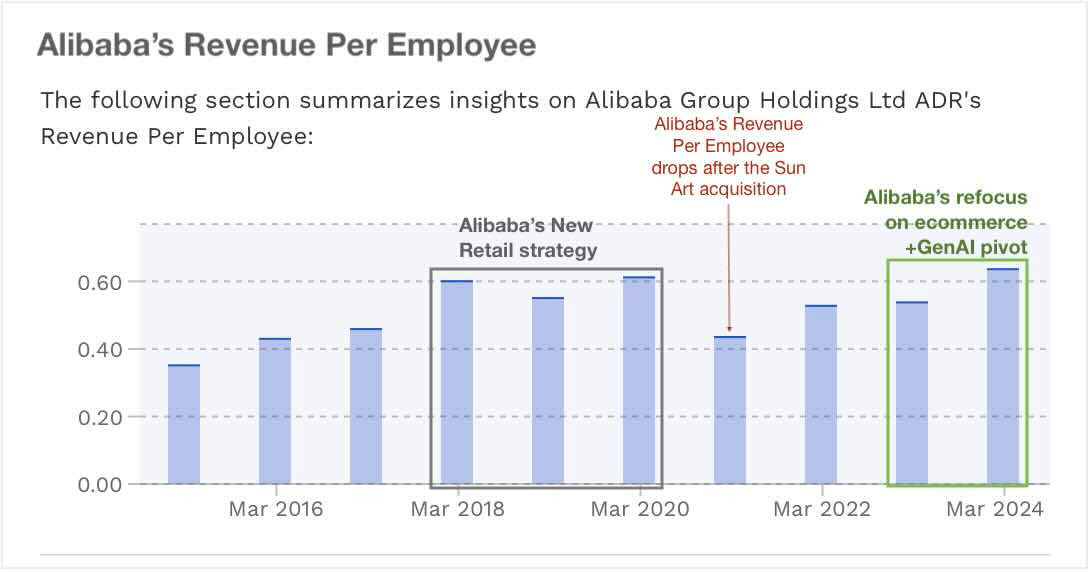«The 2-minute version»
Jack Ma’s Oopsie & The $2.8B Bill: Alibaba’s stock nosedived over 80% from its peak after a massive $2.8 billion antitrust fine in 2021, partly triggered by Jack Ma’s criticism of China’s financial system. But with regulatory scrutiny easing and Ma keeping a low profile, Alibaba has finally awoken as it takes on strategic bets, while improving its profit margins.
From Retail Regret to AI Bet: After an expensive detour into brick-and-mortar retail, Alibaba pivoted back to its strengths: e-commerce, logistics, and GenAI. Massive layoffs and restructuring set the stage for a leaner, meaner business model. Particularly, its International Digital Commerce Group is growing in excess of 30%, as Alibaba has diversified into a broad range of ex-US markets. Turns out, burning piles of cash on failing grocery chains wasn’t a great business strategy after all.
AI to the Rescue! No great comeback story comes without a touch of GenAI. Alibaba’s Qwen LLMs and new AI-powered products have given it a fresh edge, attracting major partnerships, such as Apple and new sensation Manus AI. Its cloud division, once overshadowed by AWS and Azure, is now leading China’s AI infrastructure race. Even the Chinese government seems to be warming up to Alibaba again, which is always a plus. Market’s haven’t yet realized that a humble Alibaba is a stronger Alibaba.
Mo’ Money, Mo’ Buybacks: Revenue is back on the rise, margins are expanding, and Alibaba is buying back shares aggressively, helped by China’s ultra-low-interest stimulus loans. With over $25 billion in share repurchases planned, the company is signaling confidence in its own recovery. At this rate, Alibaba’s buybacks might outpace its own customers’ shopping sprees on Singles’ Day.
Trump 2.0 Tariffs & CCP Wildcards: No doubt that political uncertainty looms, particularly around US imposed tariffs. But Alibaba’s focus on non-U.S. markets and China’s commitment to economic growth make it a strong long-term bet. The way we see it, the AI monetization flywheel is still at an early stage and as investor sentiment improves, there should be substantial upside ahead for the stock price. Read below to unlock our valuation model and price target.
⏰We’re currently running a limited time offer for all new subscribers to lock in $80 annually for a lifetime. Prices will go up to $160/year on March 17.
Sign up as a premium member by clicking on the link below.👇
Lets Set The Stage…
In the post-pandemic era, there are two defining moments that changed Alibaba’s BABA 0.00%↑ course forever.
The first was in 2021, when Chinese regulators fined Alibaba $2.8 billion for abusing its dominant market position and stifling competition. Markets were quick to trace the breadcrumbs to the shocking antitrust ruling against Alibaba to a certain speech made by its founder, Jack Ma, where he said the Chinese financial system suffered from a “pawnshop mentality.”
Alibaba accepted the ruling and vowed to change while Jack Ma stepped away from the limelight. But that didn’t stop the years-long freefall that Alibaba’s stock got sucked into.
That is until this year, where Alibaba has enjoyed the strongest start to its calendar year since 2019—its second defining moment. The main catalyst is DeepSeek’s R1 model that was quickly followed up by Alibaba’s launch of its own Qwen family of LLMs.
If DeepSeek helped stamp China’s competency in GenAI, Alibaba’s Qwen family of LLMs have possibly awoken the Chinese dragon from its deep slumber, even jolting the top leadership of China, the CCP’s Politburo, to spring into action and extend the olive branches to the technology sector it once severely chastised.
Alibaba looks vastly different from the 2020-2021 era, emerging as a leading global GenAI player, with revenue deceleration finally stabilizing, margin expansion kicking in, and shareholder returns at record levels.
This is the best that Alibaba has looked in the past 5 years, and it certainly puts the stock in a very favorable position.
This Is A New Alibaba. It's All About The Core Of Its Business
Alibaba surprised investors in 2021 when they announced their consolidated headcount had more than doubled to 252k from 122k in the prior quarter.
The surge in employee headcount at the time stemmed from Alibaba acquiring China's largest hypermarket operator, Sun Art Retail Group, for $3.6 billion. The acquisition was just one of Alibaba’s many acquisitions at the time as part of the previous management’s New Retail strategy, led by ex-CEO Daniel Zhang.
Unfortunately, this strategy put a cap on the efficiency of Alibaba, where revenue per employee topped out between 2018 and 2020, the period when Alibaba’s New Retail Strategy was born.

The New Retail strategy was a distraction from the core e-commerce business, and the timing couldn’t have been worse.
Competition among tech and e-commerce companies was already fierce. Plus, a strong crackdown from antitrust regulators in China complicated any advancements Alibaba could make, leading to margin contractions and revenue decelerations. Then there were broader macro implications Alibaba had to face with the Chinese economy contracting after the Evergrande property crisis. Realizing the burgeoning cost of its New Retail expansion strategy, Alibaba moved to swiftly axe their headcount by at least 20,000 employees through 2023.
2023 was also a pivotal year that formed the base for the strategic inflection that Alibaba is reaping rewards from today. By 2023, two things happened.
First, Alibaba successfully placated Chinese antitrust authorities by splitting the company into six divisions and assuming a holding structure similar to Google’s Alphabet corporate playbook.
Second, Daniel Zhang moved out of the chief-in-charge role, making way for two of Alibaba’s co-founders to take the reins. While Joseph Tsai assumed the role of the board’s chairman, Eddie Wu, another founder with deep technical experience leading many technology divisions for Alibaba’s companies, assumed the role of the company’s CEO.
In the past two years, the company shed weight, trimming exposure to the retail sector, thus narrowing all its resources and focusing on three core strengths of its business—e-commerce, global e-commerce logistics, and GenAI, as can be seen below.





